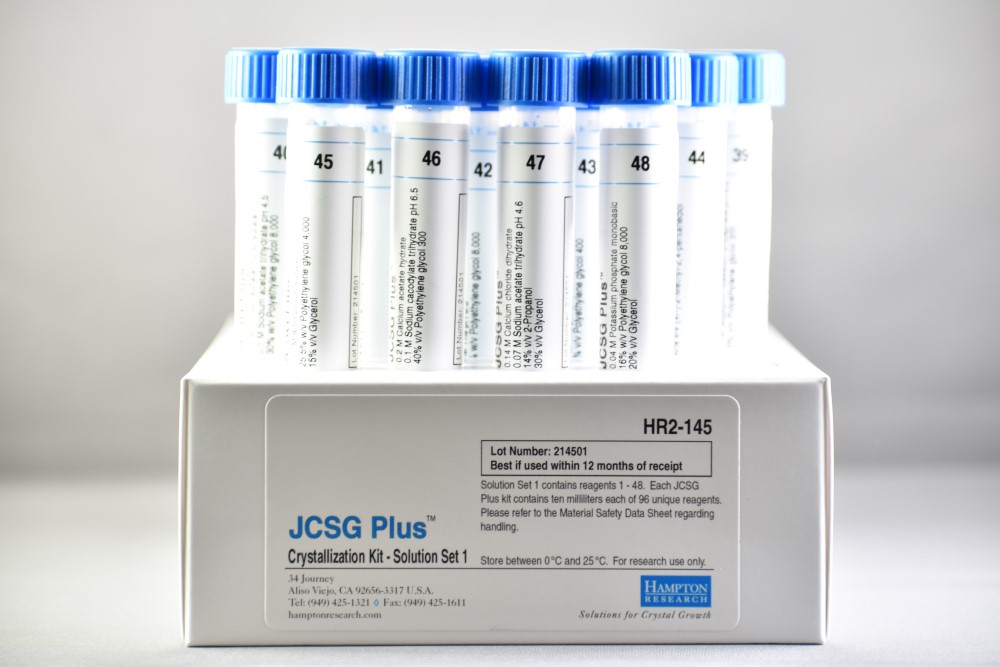
Applications
- Primary, diverse reagent system crystallization screen for proteins, complexes, peptides, nucleic acids, & water soluble small molecules
Features
- Data mined sparse matrix screen
- Efficiently samples salts, polymers, organics & pH
- PEG & Salt versus pH
- PEG & Salt
- Low ionic strength versus pH
- High [polymer] with low [salt]
- Tube or Deep Well block format
The JCSG Plus is a general sparse matrix screen. 67 core reagents are based upon a statistical analysis performed by Page1 using results of the Joint Center for Structural Genomics (JCSG), in which a large number (473) of proteins from Thermotoga maritima were each set up against 480 reagents from 12 commercially available screens.
40 of the resulting 67 reagents (60%) are Hampton Research crystallization screen reagents (Crystal Screen, Crystal Screen 2, Crystal Screen Cryo, PEG/Ion Screen, Grid Screen Ammonium Sulfate, Grid Screen PEG 6000, Grid Screen PEG/LiCl, and Grid Screen MPD). The core 67 reagents are complemented with solutions from Index², an expansion of the JCSG selected by Newman² to fill out the pH profile of the screen and to enhance the range of precipitants by including neutralized organic acids³ and Tacsimate4. Therefore JCSG Plus is composed of 96 reagents, 69 (72%) of which are based on Hampton Research screens. If one wishes to screen beyond the reagents offered in JCSG Plus one should consider PEG/Ion or PEGRx for polymer biased reagents or SaltRx for salt biased reagents
JCSG Plus contains 96 unique reagents, 10 ml each.
JCSG Plus HT contains 96 unique reagents in a single Deep Well block format.
Ready-to-use reagents are sterile filtered and formulated with ultra-pure Type 1 water, using the highest purity salts, polymers, organics and buffers. Individual reagents are also available.
References and Readings
1. Page et al (2003). Shotgun crystallization strategy for structural genomics: an optimized two-tiered crystallization screen against the Thermotoga maritima proteome. Acta Cryst. D59, 1028-1037.
2. Newman et al (2005). Towards rationalization of crystallization screening for small- to medium-sized academic laboratories: the PACT/JCSG+ strategy. Acta Cryst. D61, 1426-1431.
3. A comparison of salts for the crystallization of macromolecules. Alexander McPherson. Protein Science (2001), 10:418-422.
4. Protein and Nucleic Acid Crystallization. Methods, A Companion to Methods in Enzymology, Academic Press, Volume 1, Number 1, August 1990.
5. A comparison of salts for the crystallization of macromolecules. McPherson, A. Protein Science, 10:418-422, 2001.
6. Polymers as nucleants under high salt conditions. McPherson, A. Oral presentation at RAMC 2001, San Diego, CA. USA.
7. A novel approach to crystallizing proteins under oil. D’Arcy, A. et al. Journal of Crystal Growth, (1996) 168, 175-180.
Interested in the JCSG Plus or Hampton Research crystallization screen reagents? Our team is available for further discussion at +65 6744 6645 or

